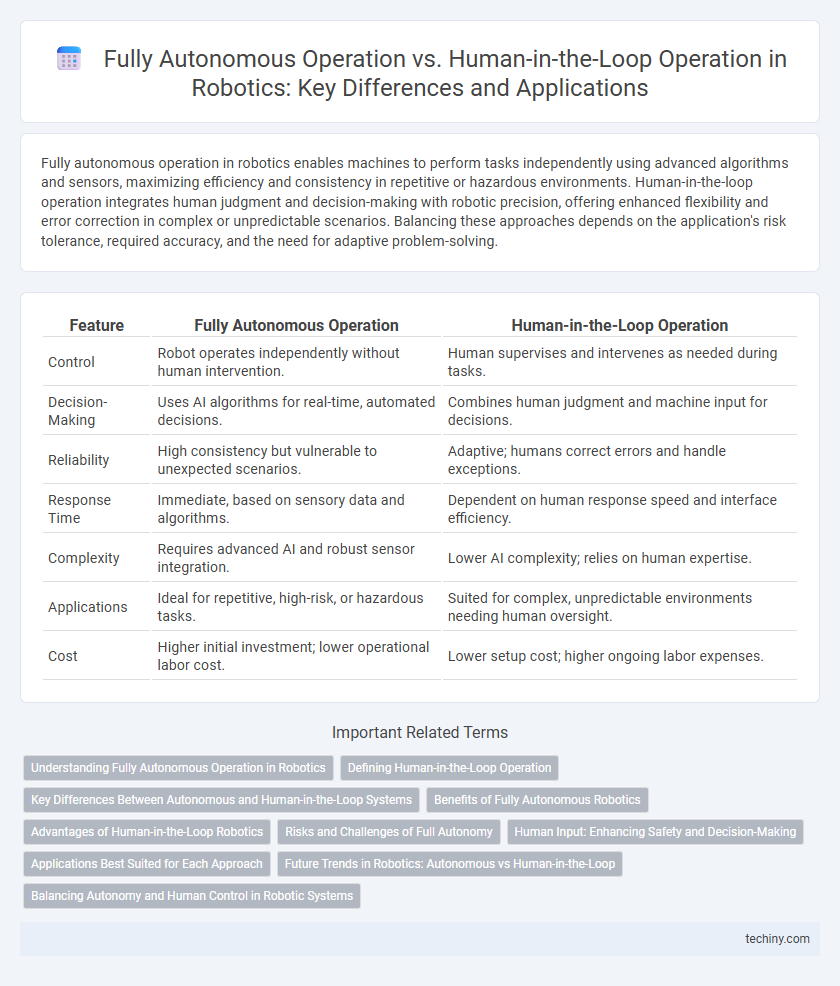Fully autonomous operation in robotics enables machines to perform tasks independently using advanced algorithms and sensors, maximizing efficiency and consistency in repetitive or hazardous environments. Human-in-the-loop operation integrates human judgment and decision-making with robotic precision, offering enhanced flexibility and error correction in complex or unpredictable scenarios. Balancing these approaches depends on the application's risk tolerance, required accuracy, and the need for adaptive problem-solving.
Table of Comparison
| Feature | Fully Autonomous Operation | Human-in-the-Loop Operation |
|---|---|---|
| Control | Robot operates independently without human intervention. | Human supervises and intervenes as needed during tasks. |
| Decision-Making | Uses AI algorithms for real-time, automated decisions. | Combines human judgment and machine input for decisions. |
| Reliability | High consistency but vulnerable to unexpected scenarios. | Adaptive; humans correct errors and handle exceptions. |
| Response Time | Immediate, based on sensory data and algorithms. | Dependent on human response speed and interface efficiency. |
| Complexity | Requires advanced AI and robust sensor integration. | Lower AI complexity; relies on human expertise. |
| Applications | Ideal for repetitive, high-risk, or hazardous tasks. | Suited for complex, unpredictable environments needing human oversight. |
| Cost | Higher initial investment; lower operational labor cost. | Lower setup cost; higher ongoing labor expenses. |
Understanding Fully Autonomous Operation in Robotics
Fully autonomous operation in robotics enables robots to perform tasks independently using advanced sensors, machine learning algorithms, and real-time data processing without human intervention. This capability improves efficiency and precision in complex environments such as manufacturing, logistics, and healthcare. Autonomous systems leverage computer vision, lidar, and AI-driven decision-making to adapt dynamically to changing conditions, minimizing errors and downtime.
Defining Human-in-the-Loop Operation
Human-in-the-loop operation integrates human decision-making into robotic control systems, allowing real-time intervention and oversight to enhance safety and adaptability. This approach leverages human judgment for complex or unforeseen scenarios that autonomous systems may not fully comprehend. By maintaining continuous feedback between human operators and robots, it ensures balanced control, combining automation efficiency with human expertise.
Key Differences Between Autonomous and Human-in-the-Loop Systems
Fully autonomous robotic systems operate independently, relying on advanced algorithms, sensors, and machine learning to perceive and interact with their environment without human intervention. In contrast, human-in-the-loop systems require continuous or intermittent human input for decision-making, enabling real-time adjustments and oversight to ensure safety and accuracy in complex or unpredictable scenarios. The key differences lie in autonomy level, decision latency, and system adaptability, with fully autonomous systems emphasizing efficiency and scalability while human-in-the-loop designs focus on human expertise integration and error mitigation.
Benefits of Fully Autonomous Robotics
Fully autonomous robotics enable continuous operation without human intervention, significantly increasing productivity and efficiency in manufacturing and logistics. These systems leverage advanced AI and sensor fusion to perform complex tasks with high precision and adaptability, reducing human error and operational costs. Enhanced data collection and real-time decision-making capabilities further optimize performance and enable scalable deployment across diverse industries.
Advantages of Human-in-the-Loop Robotics
Human-in-the-loop robotics enhances decision-making by integrating human judgment with automated processes, increasing accuracy and adaptability in complex environments. This approach improves safety by allowing real-time human intervention in unpredictable situations, reducing the risk of errors compared to fully autonomous systems. It also facilitates continuous learning and system improvement through human feedback, optimizing robot performance in dynamic tasks.
Risks and Challenges of Full Autonomy
Full autonomy in robotics introduces significant risks including system failures, unpredictable environmental interactions, and cybersecurity vulnerabilities that can lead to catastrophic outcomes. Human-in-the-loop operation mitigates these risks by allowing real-time decision-making and intervention, ensuring greater adaptability and safety in dynamic or unforeseen scenarios. The challenge of achieving fully autonomous systems lies in developing robust algorithms capable of handling complex, ambiguous data and maintaining operational integrity without human oversight.
Human Input: Enhancing Safety and Decision-Making
Human-in-the-loop operation in robotics integrates human input to enhance safety by allowing real-time intervention during complex or unexpected situations. This approach leverages human judgment to improve decision-making accuracy, reducing errors that fully autonomous systems might overlook. By combining automated processes with human oversight, the system ensures both reliability and adaptability in dynamic environments.
Applications Best Suited for Each Approach
Fully autonomous operation excels in environments requiring high precision and continuous activity, such as manufacturing assembly lines and warehouse logistics, where robots perform repetitive tasks efficiently without human intervention. Human-in-the-loop operation is preferred in complex, dynamic settings like medical surgery or disaster response, where real-time human judgment enhances decision-making and adaptability. Industries leveraging AI-powered robotics often combine both approaches to optimize productivity and safety, tailoring autonomy levels to specific operational demands.
Future Trends in Robotics: Autonomous vs Human-in-the-Loop
Future trends in robotics emphasize increased integration of fully autonomous systems powered by advanced AI algorithms and real-time sensory data processing, enabling robots to perform complex tasks independently across industries such as manufacturing, healthcare, and logistics. Human-in-the-loop operation remains critical in high-stakes environments, providing oversight, decision-making, and adaptability to unforeseen challenges, particularly in areas like military applications and surgical robotics. Emerging hybrid models combine autonomous functions with human intervention, leveraging machine learning and augmented reality to optimize efficiency, safety, and precision in robotic workflows.
Balancing Autonomy and Human Control in Robotic Systems
Balancing autonomy and human control in robotic systems enhances operational efficiency and safety by integrating fully autonomous operation with human-in-the-loop oversight. Autonomous robots utilize advanced AI algorithms for real-time decision-making, while human operators intervene in complex or unstructured environments to correct or override automated functions. This hybrid approach optimizes performance in sectors like manufacturing, healthcare, and defense, ensuring reliability and adaptability.
Fully autonomous operation vs Human-in-the-loop operation Infographic

 techiny.com
techiny.com